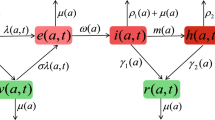Abstract
The host-parasite or host-pathogen system was analyzed from dynamical and evolutionary viewpoints using simple mathematical models incorporating vertical transmission, immunity and its loss. We first analyzed a model without density regulation of host population. In the analysis on dynamics, the condition for the pathogen to work as a density regulating factor was obtained. In the analysis on evolution, criteria for the evolution of host and pathogen were proposed. These criteria implies that the evolution of hosts should result in an increase in infected host density, whereas the evolution of pathogens a decrease in susceptible host density. The direction of evolution at some parameters of host and that of pathogen were examined when the parameters were independently and freely changeable. Among the parameters, only reduction in additional mortality due to infection was the evolutionary trend common to both host and pathogen. In all the other parameters examined, trend of evolution predicted in host is reversed in pathogen. We then analyzed whether the obtained criteria still hold in models with density regulation of hosts. Using randomly generated parameter sets, we obtained the result that the criteria should hold very likely though they do not always hold. We discussed evolution of virulence when there is a constraint between the traits.
Similar content being viewed by others
References
Anderson, R. M. (1991) Populations and infectious diseases: ecology or epidemiology?Journal of Animal Ecology 60: 1–50.
Anderson, R. M. (1994) The Croonian lecture, 1994. Populations, infectious disease and immunity: a very nonlinear world.Philosophical Transactions of the Royal Society of London Series B 346: 457–505.
Anderson, R. M. and R. M. May (1982) Coevolution of hosts and parasites.Parasitology 85: 411–426.
Anderson, R. M. and R. M. May (1991)Infectious diseases of humans. Oxford University Press, Oxford.
Bowers, R. G., M. Boots and M. Begon (1994) Life-history trade-offs and the evolution of pathogen resistance: competition between host strains.Proceedings of the Royal Society of London Series B 257: 247–253.
Bremermann, H. J. and H. R. Thieme (1989) A competitive exclusion principle for pathogen virulence.Journal of Mathematical Biology 27: 179–190.
Bull, J. J. (1994) Perspective virulence.Evolution 48: 1423–1437.
Ewald, P. W. (1994) Evolution of mutation rate and virulence among human retroviruses.Philosophical Transactions of the Royal Society of London Series B 346: 333–343.
Greenhalgh, D. (1992) Some results for an SEIR epidemic model with density dependence in the death rate.IMA Journal of Mathematics Applied in Medicine and Biology 9: 67–106.
Kakehashi, M. and F. Yoshinaga (1992) Evolution of airborne infectious diseases according to changes in characteristics of the host population.Ecological Research 7: 235–243.
Lenski, R. E. and R. M. May (1994) The evolution of virulence in parasites and pathogens: Reconciliation between two competing hypotheses.Journal of Theoretical Biology 169: 243–265.
Lipsitch, M., E. A. Herre and M. A. Nowak (1995) Host population structure and the evolution of virulence: A law of diminishing returns.Evolution 49: 743–748.
Lipsitch, M. and M. A. Nowak (1995) The evolution of virulence in sexually transmitted HIV/AIDS.Journal of Theoretical Biology 174: 427–440.
May, R. M. and R. M. Anderson (1983) Epidemiology and genetics in the coevolution of parasites and hosts.Proceedings of the Royal Society of London Series B 219: 281–313.
May, R. M. and M. A. Nowak (1994) Superinfection, Metapopulation Dynamics, and the Evolution.Journal of Theoretical Biology 170: 95–114.
May, R. M. and M. A. Nowak (1995) Coinfection and the evolution of parasite virulence.Proceedings of the Royal Society of London Series B 261: 209–215.
McNeill, W. H. (1976)Plagues and peoples. Anchor Press, New York.
McNeill, W. H. (1993) Pattern of Disease Emergence in History. pp. 29–36.In S. S. Morse, (ed.)Emerging viruses. Oxford University Press, New York.
Nowak, M. A. and R. M. May (1994) Superinfection and the evolution of parasite virulence.Proceedings of the Royal Society of London Series B 255: 81–89.
Wolfram, S. (1991)Mathematica: A system for doing mathematics by computer. Second edition. Addison-Wesley, Redwood City, California.
Yamamura, N. (1993) Vertical transmission and evolution of mutualism from parasitism.Theoretical Population Biology 43: 95–109.
Yamamura, N. (1996) Evolution of mutualistic symbiosis: a differential equation model.Researches on Population Ecology 38: 211–218.
Author information
Authors and Affiliations
Rights and permissions
About this article
Cite this article
Kakehashi, M. Populations and infectious diseases: Dynamics and evolution. Res Popul Ecol 38, 203–210 (1996). https://doi.org/10.1007/BF02515728
Received:
Accepted:
Issue Date:
DOI: https://doi.org/10.1007/BF02515728




